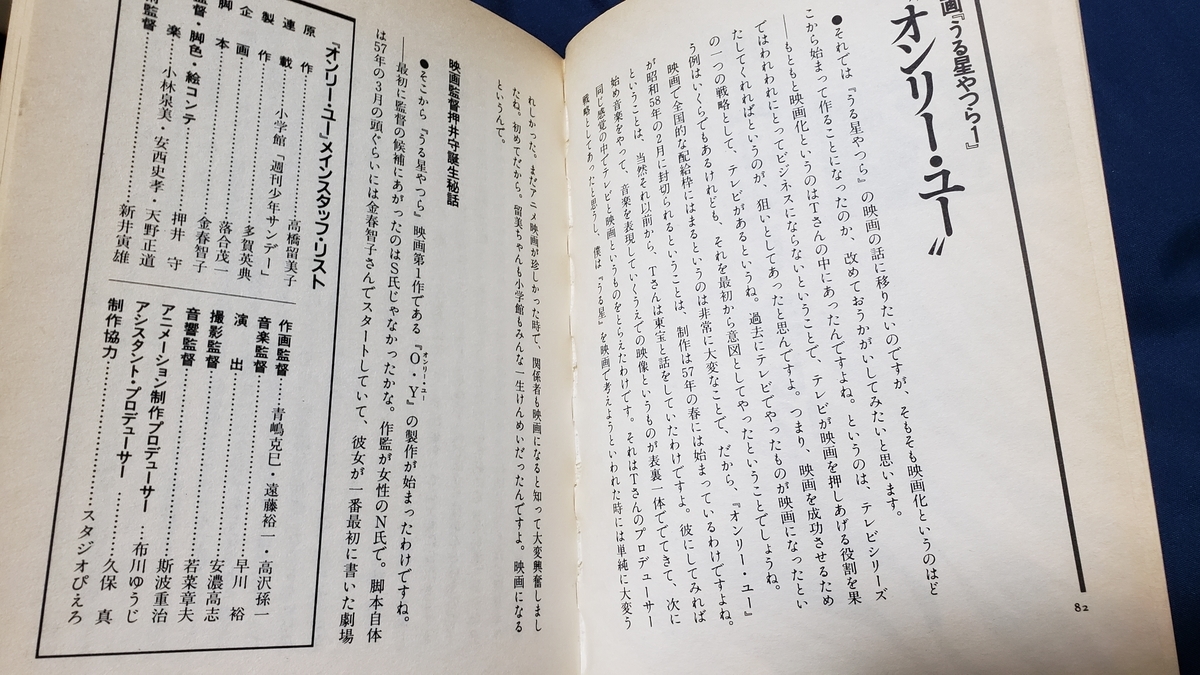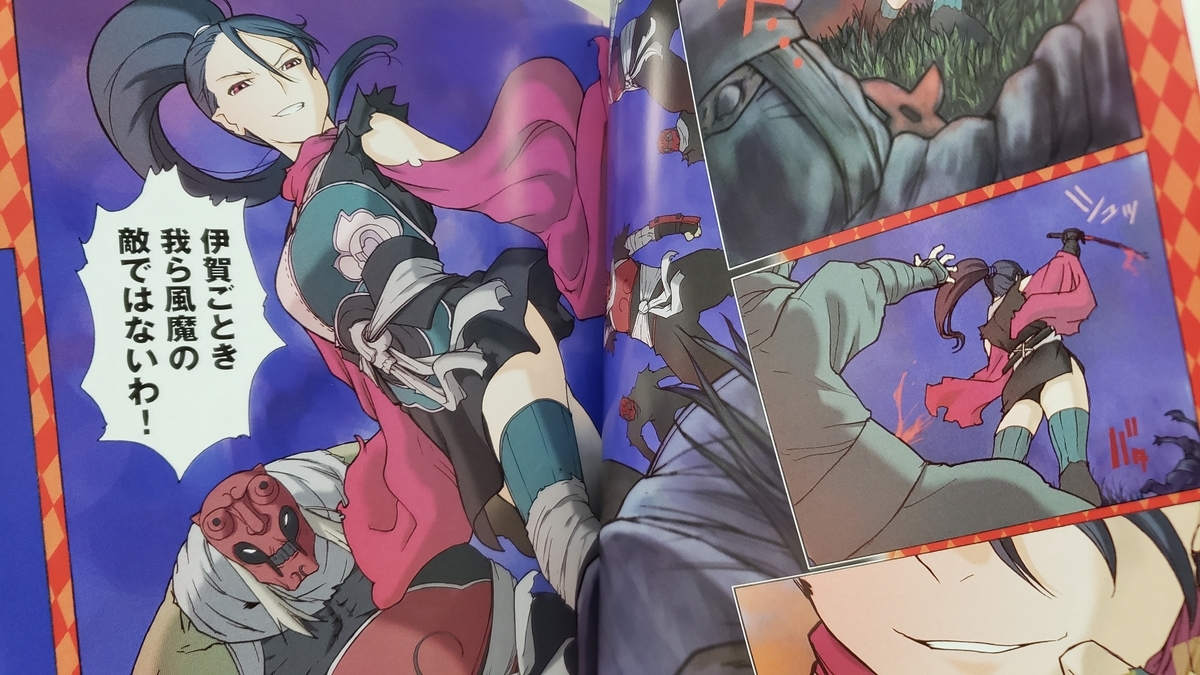-----
There're some Mamoru Oshii book lists on the Internet, but they don't have detailed explanations about the contents. My Mamoru Oshii book collection is far from complete, but I'd like to write some short summaries for each of those books.
I apologize in advance for grammatical errors and misinformation.
-----
title: 僕のプロデューサーかけだし日誌
(A Fledging Producer's Diary)
release: 12/25/1987
publisher: Triangle

[contents]
"Dear Fans", introduction
Pre-Urusei Yatsura Days
Before I became a producer
Stories Behind the TV Series Project
Contract Problems
The Begenning of the TV Series
Staffing
Originality of the Manga Author and the Anime Creators
Necessity of a Studio
Fun and Pain of the Films
Urusei Yatsura 1: Only You
Urusei Yatsura 2: Beautiful Dreamer
Urusei Yatsura 3: Remember My Love
Urusei Yatsura 4: Lum The Forever
Introduction to Urusei Yatsura 5, Kanketsu-hen
Urusei Yatsura 5: Boy Meets Girl
The Main Studio Is Magic Bus
What Is Producers' Job?
My Producer Diary
Interview: Rumiko Takahashi & Shigekazu Ochiai
Urusei Yatsura TV series: Episode List with the Main Staff List and TV-Ratings List
Afterword

[review]
This is an essay written by Shigekazu Ochiai.
Shigekazu Ochiai was a producer of Kitty Film. He is the main person who launched the Urusei Yatsura anime project. Before the release of UY Movie 5: Kanketsu-hen, he released the book to explain his situation to the fans. The fans were a bit TOO enthusiastic in those days, so he needed to calm them down.
The book starts with Ochiai's early career. He used to work in a newspaper company, but he quit and entered a university’s film department. After graduating from the university, he entered Saito Production as a scriptwriter. He became a friend of Kazuo Koike there, and they launched a small gekiga studio. They had some issues afterward, so Ochiai quit the studio. After that, he entered Tatsunoko Production. However, he couldn’t feed his family with Tatsunoko’s salary. He quit Tatsunoko and entered Kitty Film.
Ochiai knew Rumiko Takahashi from her early days because he was a supervisor of Kazuo Koike’s Gekiga Sonjuku school. From 1977, Kazuo Koike ran a gekiga creator school. That's Gekiga Sonjuku. Rumiko Takahashi was an excellent student there. So, Ochiai knew that Takahashi would be a star creator soon. That's why he launched an anime project of Urusei Yatsura in Kitty Film.
However, the Fuji TV network’s reaction was so weak at first. Ochiai explains that manga comic was not established as a culture yet in those days. Plus, Urusei Yatsura was not so popular at first. A chief editor of Shonen Sunday asked other anime studios to adapt the series earlier, but those studios just declined.
Coincidentally, Fuji TV was planning a drastic change in programming in those days. They wanted something new to put into the prime time slot. Ochiai also says that the popurality of the original manga rised during the business discussions. That helped the anime project a lot. (Still, he had to start the anime production without a formal approval by Fuji TV.)
Ochiai chose Studio Pierrot as the main studio because he thought The Wonderful Adventures of Nils was a good anime. In the Tatsunoko Production era, he was already acquainted with Pierrot’s president called Yuji Nunokawa. He says that most of the UY’s early main staff were his acquaintances. The only exception was the chief director, Mamoru Oshii. Nunokawa explained to him, “It is a challenging choice, but Oshii is a very useful person. I recommend him on my responsibility.”
Not only Oshii, but the anime’s staff got into a severe conflict with Ochiai. The staff used to say to him, “I can’t accept your correction because it’s not the director’s order.” Oshii said to him, “I can’t accept your correction because it’s the staff’s decision.” As a result, he couldn’t control the series at first. The worst thing is that they got so many complaints from fans and the TV network.
Ochiai and the head members discussed and decided two things:
First, they stopped the “two chapters in one episode” style. Ochiai chose that style because he thought it would be the best considering the source material’s pacing. But he realized that the anime staff had no free space to fill in. As a result, the staff deleted necessary scenes from the manga. They solved that problem by making whole 20 minutes episodes.
Second, they drastically changed the main staff. Yu Yamamoto used to be a head-writer, but Ochiai himself became a head writer. He was too busy to fully join the production, so Kazunori Ito acted for him. Masaki Tsuji joined the writers, and the background artist was changed to Torao Arai.
They also discussed the removal of Mamoru Oshii, but Yuji Nunokawa strongly opposed it. Ochiai admits that the team would have collapsed if they fired Oshii.
After the drastic changes, Ochiai came to receive positive reactions. He still didn’t like Oshii & Ito’s dark storytelling, though.
Ochiai says that the idea of the feature film was brought up by Kazuki Tanaka. Tanaka is a chief editor who first featured Takahashi in Shonen Sunday.
Ochiai chose Tomoko Konparu as a main-writer, but It took a long time for her to finish the script. The worse thing is that the storyboard artist took even more time. In the end, that storyboard artist was not useful, so Mamoru Oshii was brought to the film. Oshii and Konparu got into a conflict. In the climax of Only You, it is revealed that Elle froze many handsome guys and kept them in storage. That is Oshii’s idea. Konparu and Ochiai didn’t like it, but Ochiai thought as a producer that he should accept various ideas to make the film into reality.
Ochiai skipped or just didn’t know this, but Oshii was depressed by the result. It was not a “film” he imagined. He thought it was just a long version of the TV series. After that, Oshii was convinced that directors must stick to their visions no matter what. However, Ochiai, Takahashi, and the fans of UY were so happy. Ochiai was unsatisfied with the TV series, so he was glad to see fans’ positive reactions in the theaters.
The real problem was the Movie 2: Beautiful Dreamer. The idea of the second film was brought up by Toho.
Rumiko Takahashi wrote a plot at first, but she couldn’t finish it. She was too busy to correct it, so Takeshi Shudo joined as a main-writer. However, Mamoru Oshii didn’t like Shudo’s script. (The story behind Shudo’s UY2 is interesting, but Ochiai didn’t mention it in this book.) Then, Oshii recommended Kazunori Ito to Ochiai. Ito wrote a script based on episode 78, “Pitiful! Mother of Love and Banishment!?”. Ochiai declined it for the obvious reason. When they ran out of time, Oshii said to Ochiai, “I have an idea”. Ochiai thought Oshii’s new plot was pretty good. Takahashi was not satisfied with the plot, but he convinced her. (He skipped or didn’t know this, but it was Oshii’s conspiracy. Oshii intentionally prepared the “make this, or cancel the project” situation to make his vision into reality. Oshii himself says so in some books.)
The real problem was the storyboard. When Ochiai checked the first third of the storyboard, he realized that it was totally different from the plot. He still ordered some correction, but he couldn’t do anything with the limited schedule. He says, “I wanted to quit and run away with the finished storyboard.” After the preview, he thought, “I admit that Oshii is an extremely talented director, but how dare he make a UY film like this?”
After the preview, Rumiko Takahashi said, “The manga is manga, the film is film. The film has its own merits. It is based on my manga, but the film staff must make it into a film. That’s my thoughts on the film.”
After finishing Beautiful Dreamer, Oshii quit, saying, “I burnt out.” Ochiai got angry and thought, “What are you, Ashita no Joe?”
BD’s box office was so bad, but the home video sold well. That “unpopular in theaters, but popular in the home video” aspect can be commonly seen in Oshii’s anime. Even BD is pretty popular compared to Oshii’s other anime. (GitS sold so poorly in theaters.)
Ochiai thinks that BD was a really bad choice for Urusei Yatsura as a franchise. The other creators like Kazuo Yamazaki were influenced by BD, and UY went to the “niche” side of anime. Ochiai thinks that UY should be more mainstream, so he doesn’t like the tone set by Oshii.
After that, Ochiai talks about other films and Movie 5. I skip that part because this review is a part of the “Mamoru Oshii book list”. Plus, the most interesting part is from the launch of the TV series to BD.
What interested me is the story behind the “They Were Eleven” film project. “They Were Eleven” is Moto Hagio’s famous manga series in 1975. When Kitty Film decided to adapt it into a feature film, Hagio requested that Mamoru Oshii direct the film. She watched Beautiful Dreamer and liked it. She was interested in how Oshii would handle her manga in the film form. Oshii was making Angel’s Egg at that time, so They Were Eleven was directed by Satoshi Dezaki. Ochiai didn’t mention this, but Moto Hagio became a big fan of Angel’s Egg.
The interview with Rumiko Takahashi might be important to her fans, but, to be honest, it is not so interesting to me. If you’re interested in interviews with her, I recommend other books.
To conclude, this is a must-buy book even to Oshii fans. It explains many aspects Oshii doesn’t mention in other books. The unfortunate thing is that it is out-of-print after the first print. I hope someone will reprint and translate it.











